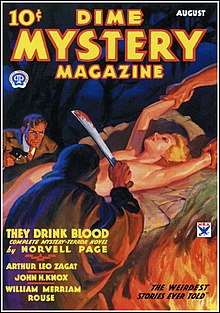Pulp magazines were inexpensive fiction magazines that were published from 1896 until around 1955. The term "pulp" derives from the cheap wood pulp paper on which the magazines were printed. In contrast, magazines printed on higher-quality paper were called "glossies" or "slicks". The typical pulp magazine had 128 pages; it was 7 inches (18 cm) wide by 10 inches (25 cm) high, and 0.5 inches (1.3 cm) thick, with ragged, untrimmed edges. Pulps were the successors to the penny dreadfuls, dime novels, and short-fiction magazines of the 19th century.

Mystery is a fiction genre where the nature of an event, usually a murder or other crime, remains mysterious until the end of the story. Often within a closed circle of suspects, each suspect is usually provided with a credible motive and a reasonable opportunity for committing the crime. The central character is often a detective, who eventually solves the mystery by logical deduction from facts presented to the reader. Some mystery books are non-fiction. Mystery fiction can be detective stories in which the emphasis is on the puzzle or suspense element and its logical solution such as a whodunit. Mystery fiction can be contrasted with hardboiled detective stories, which focus on action and gritty realism.

Carl Richard Jacobi was an American journalist and writer. He wrote short stories in the horror and fantasy genres for the pulp magazine market, appearing in such pulps of the bizarre and uncanny as Thrilling, Ghost Stories, Startling Stories, Thrilling Wonder Stories and Strange Stories. He also wrote stories crime and adventure which appeared in such pulps as Thrilling Adventures, Complete Stories, Top-Notch, Short Stories, The Skipper, Doc Savage and Dime Adventures Magazine. Jacobi also produced some science fiction, mainly space opera, published in such magazines as Planet Stories. He was one of the last surviving pulp-fictioneers to have contributed to the legendary American horror magazine Weird Tales during its "glory days". His stories have been translated into French, Swedish, Danish and Dutch.
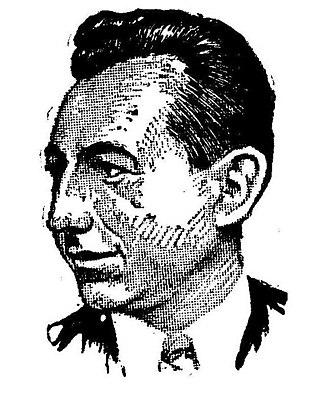
Nathaniel Schachner, who published under the names Nat Schachner and Nathan Schachner, was an American writer, historian, and attorney, as well as an early advocate of the development of rockets for space travel. A prominent author of historical works on figures from America's Revolutionary Era, Schachner also was a regular contributor to the genre leading up to and during the early years of what came to be referred to as the Golden Age of Science Fiction.

Hugh Barnett Cave was an American writer of various genres, perhaps best remembered for his works of horror, weird menace and science fiction. Cave was one of the most prolific contributors to pulp magazines of the 1920s and '30s, selling an estimated 800 stories not only in the aforementioned genres but also in western, fantasy, adventure, crime, romance and non-fiction. He used a variety of pen names, notably Justin Case under which name he created the antihero The Eel. A war correspondent during World War II, Cave afterwards settled in Jamaica where he owned and managed a coffee plantation and continued his writing career, now specializing in novels as well as fiction and non-fiction sales to mainstream magazines.
Popular Publications was one of the largest publishers of pulp magazines during its existence, at one point publishing 42 different titles per month. Company titles included detective, adventure, romance, and Western fiction. They were also known for the several 'weird menace' titles. They also published several pulp hero or character pulps.
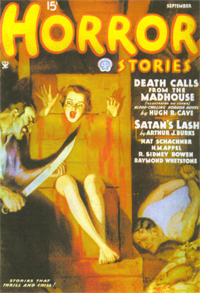
Horror Stories was an American pulp magazine that published tales of the supernatural, horror, and macabre. The first issue was published in January 1935, three years after the weird menace genre had begun with Dime Mystery Magazine. Horror Stories was a sister magazine to Terror Tales, whose first issue came out a year earlier. The title went on to become one of the major pulp magazines of the 1930s.
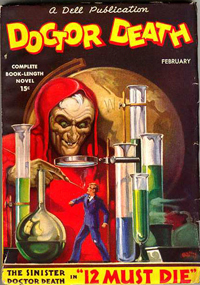
Doctor Death was the title of a short-lived pulp science fiction magazine published by Dell Magazines in 1935, as well as the name of the main character featured in that magazine. Doctor Death was an archcriminal who wanted to return the world to a primitive condition and used supernatural tools such as zombies and magic in his plots against humanity. The stories were written by Harold Ward under the pseudonym of "Zorro". Dell may have intended Doctor Death to be a continuation of a character of the same name in All Detective Magazine, also published by Dell.

Paul Chadwick (1902–1972) was a pulp magazine author who wrote many stories under his own name and various pseudonyms. As was the case with many prolific contributors to the pulps, he wrote in a number of different genres including detective stories, science fiction and westerns. He created Secret Agent X, published under the "house name" of Brant House, and also wrote the one and only issue of the Doc Savage clone Captain Hazzard under the name of Chester Hawks.

Arthur Josephus Burks was an American Marine officer and fiction writer.

Windom Wayne Robbins was an American author of horror and weird fiction. His work was primarily published in the Popular Publications catalog of weird menace pulp fiction. His first published short story was Horror's Holiday Special in the July 1939 issue of Dime Mystery Magazine.
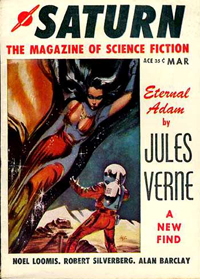
Saturn was an American magazine published from 1957 to 1965. It was launched as a science fiction magazine, but sales were weak, and after five issues the publisher, Robert C. Sproul, switched the magazine to hardboiled detective fiction that emphasized sex and sadism. Sproul retitled the magazine Saturn Web Detective Story Magazine to support the change, and shortened the title to Web Detective Stories the following year. In 1962, the title was changed yet again, this time to Web Terror Stories, and the contents became mostly weird menace tales—a genre in which apparently supernatural powers are revealed to have a logical explanation at the end of the story.

Henry Steeger III was an American magazine editor and publisher.
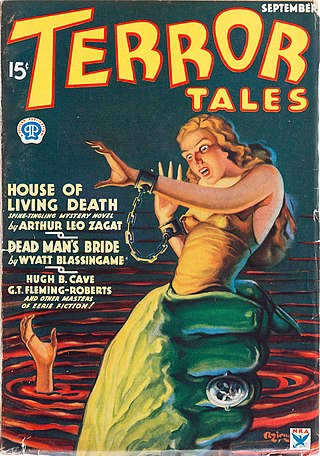
Terror Tales was the name of two American publications: a pulp magazine of the weird menace genre of the 1930s, and a horror comic in the 1960s and 1970s.
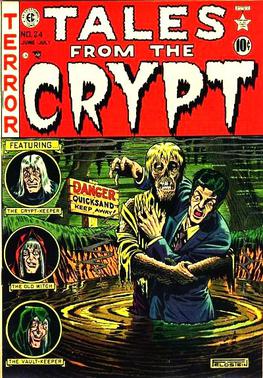
Horror comics are comic books, graphic novels, black-and-white comics magazines, and manga focusing on horror fiction. In the US market, horror comic books reached a peak in the late 1940s through the mid-1950s, when concern over content and the imposition of the self-censorship Comics Code Authority contributed to the demise of many titles and the toning down of others. Black-and-white horror-comics magazines, which did not fall under the Code, flourished from the mid-1960s through the early 1980s from a variety of publishers. Mainstream American color comic books experienced a horror resurgence in the 1970s, following a loosening of the Code. While the genre has had greater and lesser periods of popularity, it occupies a firm niche in comics as of the 2010s.

Ormond Orlea Robbins was an American author of hardboiled detective fiction and weird fiction. His work was primarily published in the Popular Publications catalog of pulp fiction. The most part of his work for Popular Publications was attributed to his pen names Dane Gregory and, occasionally, Breck Tarrant.
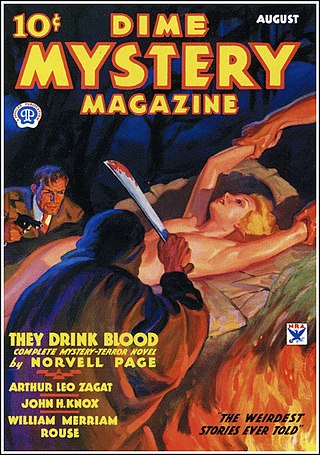
Dime Mystery Magazine was an American pulp magazine published from 1932 to 1950 by Popular Publications. Titled Dime Mystery Book Magazine during its first nine months, it contained ordinary mystery stories, including a full-length novel in each issue, but it was competing with Detective Novels Magazine and Detective Classics, two established magazines from a rival publisher, and failed to sell well. With the October 1933 issue the editorial policy changed, and it began publishing horror stories. Under the new policy, each story's protagonist had to struggle against something that appeared to be supernatural, but would eventually be revealed to have an everyday explanation. The new genre became known as "weird menace" fiction; the publisher, Harry Steeger, was inspired to create the new policy by the gory dramatizations he had seen at the Grand Guignol theater in Paris. Stories based on supernatural events were rare in Dime Mystery, but did occasionally appear.
Thrilling Mystery was an American pulp magazine published from 1935 to 1944. New York publisher Standard Magazines had a stable of magazines with the "Thrilling" prefix, including Thrilling Detective, Thrilling Love, and Thrilling Adventures, but in 1935, Popular Publications, a rival publisher, launched a weird menace pulp titled Thrilling Mysteries. Standard Magazines sued over the use of the word "Thrilling", and Popular conceded, settling out of court. Thrilling Mysteries was cancelled after a single issue, and in October 1935 Standard began Thrilling Mystery. Like Thrilling Mysteries this was a terror pulp, but it contained less sex and violence than most of the genre, and as a result, in the opinion of science fiction historian Mike Ashley, "the stories had greater originality, although they are not necessarily of better quality". Ashley singles out Carl Jacobi's "Satan's Kite", about a family cursed because of a theft from a temple in Borneo, as worthy of mention. There were two detective stories by Robert E. Howard, the creator of Conan. Other contributors included Fritz Leiber, Fredric Brown, Seabury Quinn, Robert Bloch, and Henry Kuttner. There was little science fiction in the magazine, but some fantasy: pulp historian Robert K. Jones cites Arthur J. Burks "Devils in the Dust" as "one of the most effective" stories, with "a mood as bleak as an arctic blizzard", and Ashley agrees, calling it "particularly powerful".

Eerie Stories was an American weird menace pulp magazine that published one issue in 1937. The publisher had failed with another weird menace pulp, Ace Mystery, the year before, and pulp historian Robert K. Jones comments that Eerie Stories was "even feebler". All twelve stories were written under house names; one, "Mate of the Beast" by Leon Dupont, was a reprint from Ace Mystery with a new title, and there may have been other reprints. In the opinion of pulp historian Michael L. Cook, the stories "really had no redeeming value and were even poor entertainment". The tagline was "Startling Adventures in Chilling Horror", but in Jones' opinion the stories fell short.

Eerie Mysteries was an American weird menace pulp magazine that published four issues in 1938 and 1939. This was Ace Magazines' third weird menace pulp, and it was no more successful than its predecessors, Ace Mystery and Eerie Stories. As with Eerie Stories, the contents were all pseudonymous, and some were reprints from Ace Mystery or Ten Detective Aces, another Ace Magazines title, where the original detective story had enough violence to be a suitable candidate. The magazine's tagline was "10 Complete Horror-Thrillers", and the reprints had their titles changed to suit the new magazine, but the new titles, such as "When It Rained Corpses" by Ralph Powers, or "Skull and Double Cross-Bones" by Eric Lennon, stressed sex less than earlier weird menace magazines had done, and pulp historian Peter Haining cites Eerie Mysteries as an example of a magazine attempting to cash in on a trend that was already starting to fade away. Haining adds that the contents were also tamer than usual: "descriptions of beautiful females being molested and tortured were notably fewer". All four covers were painted by Norman Saunders, and Haining suggests that some or all of the interior art was re-used from other Ace Magazines titles.
